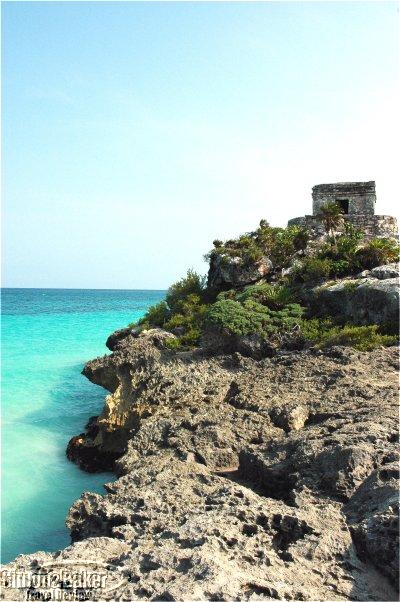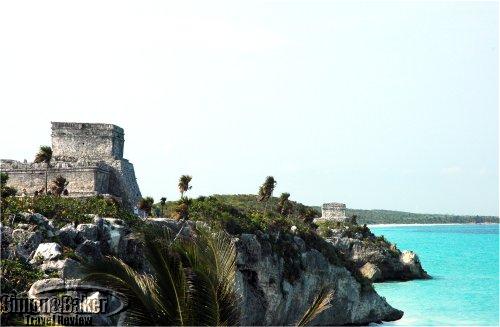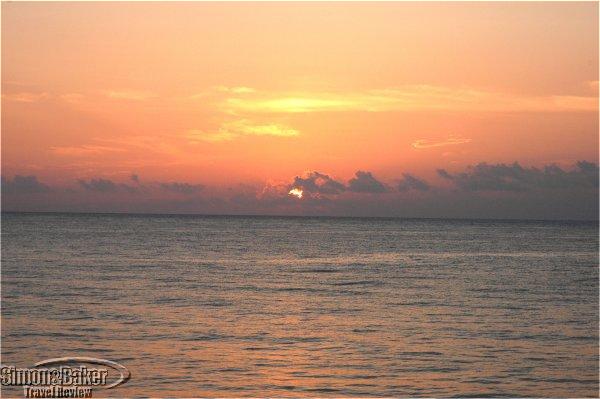Overall Impression A secluded barefoot-casual, sun drenched enclave of small cabana hotel s nestled between tropical jungle vegetation and the gentle surf of the Caribbean Sea, Tulum was an idyllic “base camp” to explore the nearby archeological and natural wonders of Mexico ’s Yucatan peninsula. When we last visited Tulum, it was a barely visible icon on the map of the Yucatan , indicating the presence of a not yet excavated minor Maya site. Luxuriant tropical vegetation encroached in places upon the narrow, intermittently paved jungle road that took us there. Things have changed a lot in the past thirty years. Today, Tulum is definitely on the map! Easily accessible via a modern highway, as well as a stopping point for cruise ships, it has become one of the most visited Maya sites in the Yucatan . The spot, although small and structurally far less impressive than others nearby such as Chichen Itza , Uxmal and Coba , is spectacularly perched on the edge of a limestone cliff overlooking the turquoise waters of the Caribbean .
In addition to the fully excavated 12 th century walled port city, there are now two contemporary components to Tulum: Tulum Pueblo , an unremarkable small town divided into two halves by Federal Highway # 307 approximately four miles south of the archeological site, and the Tulum Zona Hotelera ( hotel zone). Starting about two miles south of the ruins, this area of small eco-friendly, beach-hugging cabana hotel s offers a welcome antidote to the concrete jungle now sprawling from Cancun to Playa del Carmen. Easy access to the Tulum ruins has made it a popular destination for day-trippers. Next time we are in the area we will make sure to visit before 9 am or at the end of the day, around 4 pm , to avoid the crowds.
The choice of accommodations runs from basic to luxury. With its easy road access to several major archeological sites and ecological preserves in the area, and immediate proximity to all water sports, we found the comfortable, relative seclusion and the pristine white coral sand beaches of the Tulum Zona Hotelera a good reason to linger for several days
Location, location, location! In addition to its easy access to notable archeological sizes, Tulum, with the second largest coral reef in the world situated only a few meters from its shore line is a diver’s and snorkler’s paradise. Further underwater delights can be found a short distance inland, where a number of crystal clear Cenotes (limestone pools fed by an underwater river) offer interesting underwater rock formations. About three miles south of Tulum, the Sian Ka’an Biosphere Reserve is a 1.3 million acre national park of impressive mangrove swamps and tropical vegetation that are home to abundant wildlife including hundreds of species of birds.
Cost Of Visiting Moderate
Currency Mexico ’s currency is the peso. The peso symbol is ‘$’
Electrical Current 110 Volts
Health And Vaccinations Though there were no mandatory inoculations to enter the Mexico at the time of our visit, it is prudent to keep an eye on advisories such as the Center for Disease Control in the U.S. In Mexico , the “don’t drink water from the tap” rule applies to brushing teeth as well. We made sure to use the bottled water in our room for that purpose.
How To Get There The majority of travelers to this area arrive by air through the Aeropuerto Internacional de Cancun . This busy airport receives up to 80 international flights per day at the height of the season, mainly from major North American and European airlines. The Yucatan peninsula’s other four minor international airports are in Campeche , Cozumel , Chetumal and Merida .
Location In Mexico ’s Yucatan peninsula on the Gulf of Mexico, Tulum is approximately 125 Kilometer (75 miles) south of Cancun Airport by the new multi-lane Federal Highway #307. The drive takes approximately ninety minutes.
Measures The metric system prevails
Money Issues The peso had an exchange rate of around 11 pesos per U.S. dollar at the time of our visit. The easiest way to exchange U.S. dollars for pesos is by using ATM machines, available at the Cancun airport and several bank locations around the area.
Technology Tulum is an ecology-conscious enclave in the jungle. Electricity is provided by generators in all tourist areas. Running water is available with the usual conservation recommendations. During our stay, we were not aware that television reception was available anywhere in Tulum. However, wireless Internet access was broadly available, as was excellent cell phone reception.
Time GMT/UTC -6 (e.g. U S Central Time)
Transportation For those intending to visit extensively around the area, renting a car is an option. The main roads are well maintained and with reasonably good signage. For those planning to mainly enjoy the secluded beaches and local resources of Tulum, taxis are available and reasonably priced.
Facilities Small town facilities such as grocery stores, drugstores, restaurants, sidewalk cafes, and first aid healthcare were available in Tulum Pueblo. The nearest hospital was located in Playa del Carmen, a 45 minute drive North on Federal Highway # 307. In the
Tulum Zona Hotelera , convenience stores provided the basic necessities. Most of the hotel s included small casual restaurants. We especially enjoyed the palm shaded terrace and the simple but delicious cuisine of the Zahra Hotel.
Shopping And Souvenirs We found no shopping of note in Tulum; only the usual souvenir shops with the ubiquitous local pottery, jewelry and textiles . Basic necessities were readily available from small convenience stores and drugstores.
Tourism Highlights The area is blessed with so many archeological and natural wonders that selection is a matter of personal interest. We especially enjoyed our visit to the Coba ruins, an impressive partially excavated site of high pyramids in the heart of the jungle about one hour’s drive west of Tulum. We also visited the Sian Ka’an Biosphere (‘Where the ski begins’ in Mayan language), which was classified by the United Nations in 1987 as a World Heritage site. We visited it with a professional guide, as there are no hiking trails on the Reserve. Tours were easy to arrange through the hotels.
Other Tulum is located in a tropical jungle area. We made sure to pack our most effective mosquito repellant. Also the tropical sun combined with the high reflective quality of the vaunted white coral sand beaches of the Yucatan can quickly cause sunburns. Sunscreen is a must!
Date Of Latest Visit May 2005
Reviewers Article and photographs by Josette King
Would You Visit This Destination Again? Yes



